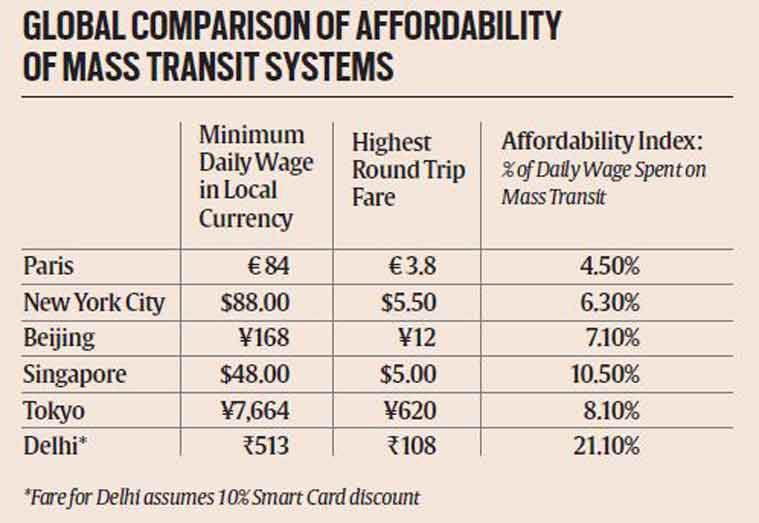What is the issue?
- A steep 100% fare hike was implemented by the DMRC within a span of five months.
- This ignores the fact that affordability is at the heart of all successful mass transit systems globally.
Why was fair hiked?
- The DMRC has justified the hike citing loan repayments, mounting operational expenses and financial sustainablity.
- Other Indian cities like Kochi and Chennai too have comparable fares to DMRC – which makes them too a costly affair.
- This implies that despite India’s commendable technical capacity to build and run metro systems their pricing policies are rudimentary.
- Costs are narrowly focused on financial sustainability disregarding affordability for the masses.
- The larger spillover benefits to the society due to affordable ‘mass transit systems’ are thereby mostly left unaccounbted.
What is the affordability argument?
- Pricing of urban mass transit systems has been a difficult challenge globally.
- It needs a careful balance between financial sustainability and affordability, especially for the lower income populations.
- These people usually stay in outermost pockets of the city and tend to travel the longest distances.
- Affordability of public transit is globally measured as percentage of income that is spent on transit.
- The following table on ‘Affordability Index’ of mass-transit systems across top global cities is an eye opener.

- Clearly, Delhi - which by far has the highest poverty rate among the cities in comparison, has a strikingly high metro fare structure.
- Delhi metro's fare structure also ignores other equity concerns by not providing any targeted concessions to children, students, or senior citizens which is a norm elsewhere.
Is the estimate accurate?
- The estimated ‘Affordability Index’ for Delhi is at best a conservative figure and can be even worse in actuality.
- This is because the table has assumed that the minimum wage, fixed by the Delhi government is a ground reality which usually isn’t.
- Also, the roundtrip fare on public transit is a lower estimate of the daily expense since it hasn’t accounted further transport for lastmile connectivity (through buses, autos etc...).
- As Delhi metro’s last mile connectivity is considerably poor, this could eat-up almost 40% of a wages earned by casual labourers.
What are the dominating trends in pricing policy research?
- A paper in the ‘American Economic Review’ on mass transit pricing models for 20 US cities was published recently.
- It factored in the welfare effects of reduced congestion, pollution, accidents in fares.
- The results supported the efficiency of large fare subsidies stareing at upto 50% of operating costs.
- In another study, that examined transit fares in London, subsidies were found to be the most effective way to usher in equity and re-distribute income.
What could be the larger economic benefits?
- Arguements against transit subsidies often ignore the multiplier effect that an efficient and affordable mass transit system can have on the economy.
- In Delhi itself, in the last two years, the GDP (State) has risen by 13% annually with a concurrent surge in tax collections.
- While multiple factors enable this, the contribution of the Delhi metro in supporting high economic growth is far from negligible.
What could be the strategy ahead?
- Like many western metros, the Delhi government and the Centre could jointly consider subsidising the costs of DMRC.
- While financial obligations are worked out, care should be taken to retain the operational autonomy of DMRC.
- DMRC should also work for generating substantially more revenues from its non-fare collections (property rentals, advertisements etc).
- While such revenues for DMRC stands at 19% currently, Hong Kong metro generates as much as 37% from non-far revenue.
What are the hopes?
- Delhi metro has been a model for all Indian cities.
- It also remains the city's best bet to fight worsening air pollution, congestion, and the declining modal share of public transit.
- It now has to make the curtail decision on whether to prioritise financial self-sustainability over enjoying an increased ridership.
- Its choices will indeed impact on the lives of millions people and the economic trajectory of the national capital in a big way.
Source: Indian Express
